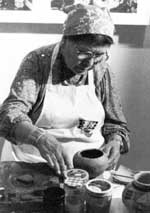Daisy Hooee facts for kids
Quick facts for kids
Daisy Hooee Nampeyo
|
|
|---|---|
 |
|
| Born | 1906 or 1910 |
| Died | 1994 or 1998 |
| Nationality | Hopi |
| Education | École des Beaux-Arts |
| Known for | Pottery |
| Patron(s) | Anita Baldwin |
Daisy Hooee Nampeyo (born around 1906 or 1910, died around 1994 or 1998) was a talented Hopi-Tewa potter. She learned her craft from her famous grandmother, Nampeyo. Daisy even studied art in Paris, France, at a special school called the École des Beaux-Arts. She later taught pottery making on the Zuni reservation, helping to keep traditional techniques alive.
About Daisy's Life
Daisy Hooee was born into the Hopi-Tewa community in Hano, which is part of First Mesa, Arizona. She was the granddaughter of the famous potter Nampeyo and the daughter of Annie Healing. Daisy started learning to paint pottery from her grandmother before she was even ten years old!
When Daisy was about ten, she found out she had cataracts, which could make her go blind. A kind art supporter named Anita Baldwin helped Daisy get surgery in California. After that, Baldwin made sure Daisy got a great education. She took Daisy to school in Paris, where she studied art, and even showed her different parts of the world. Daisy lived with Baldwin for about ten years.
Daisy returned to her Hopi community when her mother became ill. She settled in Polacca, Arizona and worked as a cook at a school. In the 1920s, Daisy worked with the Zuni and helped form a dancing and singing group called the Olla Maidens. This group still performs today!
Daisy's son, Raymond Naha, was born in 1930 and also became an artist. Daisy married her first husband, Ray Naha, in 1935. She also worked with archaeologists from the Peabody Museum at the Awatovi Ruins excavation site. Later, she married Leo Poblano, a silversmith, in 1938. Sadly, Leo died in 1959 while fighting a forest fire in California. Daisy later married another silversmith named Sidney Hooee. She passed away in the mid-1990s.
A book about Daisy's life, Daisy Hooee Nampeyo, was written in 1977. She was also featured in a 1981 documentary film called The Pueblo Presence.
Daisy's Amazing Art Work
Daisy Hooee's pottery shows many different influences. She learned how to make pottery from her grandmother, Nampeyo, so her early pieces looked a lot like the traditional Sikyatki style. Daisy was also inspired by pots found at the Awatovi Ruins archaeological site.
She also added Zuni influences to her work. For example, she used white clay and a special "high shouldered water jar form." Daisy made her pottery using clay found right in her local area. Her work was often polychrome, meaning it had many colors. She fired her pottery in ovens using sheep dung as fuel, or coal when it was available. Daisy often signed her work simply as "Nampeyo."
For a short time, Daisy also created sculpture and worked with silversmithing. She and her husband, Leo Poblano, who was a silversmith, introduced a special kind of relief work to the Zuni people. Daisy also taught pottery at Zuni High School. In the mid-1970s, she worked on the Zuni Pottery Project, teaching Zuni potters how to make traditional pots. It was very important to Daisy that the old ways of making pottery did not disappear.
Daisy also gave talks and showed how she made her pottery. Once, a museum called the Honolulu Academy of Arts (now Honolulu Museum of Art) even brought in 400 pounds of sheep dung for her pottery oven when she visited in 1974!
You can find Daisy Hooee's artwork in the collection of the Smithsonian American Art Museum.
Images for kids


